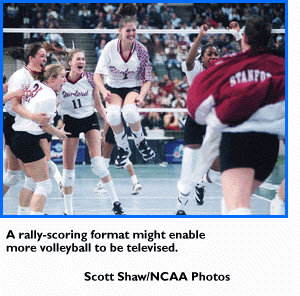The NCAA News - News and FeaturesNovember 17, 1997
A matter of time
Volleyball community considers extending rally scoring to limit length of matches and enhance television appeal
BY SHAWNA HANSEN
STAFF WRITER
"Rally! Rally!"
That cry will come not just from baseball dugouts this season but also on volleyball courts.
 There is an ongoing debate in the volleyball community about why the game is not televised more. Many believe that a rally-scoring format is a solution that will accommodate a two-hour television format. There is an ongoing debate in the volleyball community about why the game is not televised more. Many believe that a rally-scoring format is a solution that will accommodate a two-hour television format.
Chuck Erbe, head women's volleyball coach at Michigan State University, has written many proposals to change the volleyball format and make it adaptable for live broadcast.
"The single most important issue for volleyball is changing the format so it fits into a predictable TV format in an exciting atmosphere," he said.
Timed game
Erbe's newest format proposes a best-two-of-three, timed game based on rally scoring and two points for back-row attack.
The first two games would be 14 minutes on a "ball-in-play clock," which would produce 41 minutes of play without timeouts or substitutions. At the seven-minute mark, the game would stop and teams would trade sides.
Coaches would turn in another lineup to adjust matchups and restart substitutions. A running score would be kept until the end of the game, which could be won by one point.
After a 10-minute intermission, game two would be played the same as game one.
A third game would be played if the teams split the first two games. Game three would be a 15-point, rally-scored game and must be won by two points.
Under this format, a match would run one hour and 56 minutes.
"Match management would be crucial in order to stay within the allotted time frame. This applies to floor wiping, substitution protocol, delays by players before serving, delay tactics by coaches and refereeing protocol," Erbe said.
He said the new format also creates a faster-paced game. Points can be scored in every situation, and awarding two points for back-row attack adds excitement.
"It is like the home run in baseball, the long bomb in football for the touchdown and the three-point shot in basketball," he said. "Plus setters, hitters and coaches are more aware of the need to diversify their offenses and defenses."
Erbe said the timed format is appealing to fans not only because of the added excitement, but because they know that a match that starts at 7 p.m. will end by 9 p.m. Erbe believes this could entice more fans, including young families, to attend matches.
Longtime issue
Adjusting the format to televise volleyball is a longtime issue.
Matches are televised, but the numbers are low. From 1992 to 1995, an average of 57 collegiate matches were televised. In 1996, that number grew to 84.
Proponents claim the new format would work for television because it would fit into two-hour time blocks.
"In general, anytime you can make the game more TV-friendly, it enhances your TV opportunities," said ESPN spokesman Dean Diltz.
This year, ESPN and ESPN2 will televise 10 collegiate matches, including the Division I Women's Volleyball Championship in December.
"Beach volleyball tailored their event to TV and it worked. ESPN would definitely be interested in televising more collegiate volleyball with a predictable timed format," Diltz said.
The Division I championship's semifinal and final matches, televised by ESPN 2, already use a rally-scoring format in the fifth and deciding game.
Christine Holyes, former chair of the Division I Women's Volleyball Committee, said the change was made "to confine the length of matches to fit into what television needed for the two-hour format" as well as "attract the general fan" with a more exciting format.
In 1996, the Big Ten Conference experimented with a rally-scored format for eight conference matches. All eight contests were televised.
Mary Masters, assistant conference commissioner, said the experiment was moderately successful but needs to be broadened to a national level.
National groundswell sought
"We had wanted to stimulate interest with our experiment and to start it on a nationwide level," Masters said. "A groundswell needs to occur to reach a decision on a new format but still protect the integrity of the game and retain the essence that makes volleyball a unique sport."
Lisa Love, president of the American Volleyball Coaches Association (AVCA), said "this is an emotional issue, and from the traditionalists' standpoint, changing how the game is scored changes the way volleyball was to be played.
"The ability to come from behind is one of the dramatic parts of this game," she said.
Love added that side-out scoring is extending matches to three-plus hours in the women's game and four hours in the men's game. She believes there may be a need to get away from side-out scoring.
"There is an open attitude among the volleyball community to try an experimental change," Love said. "If changes are to be made, they must be made one step at a time. Having a point-per-play format is the first step at an experiment that is palatable to the volleyball audience at large."
The AVCA will feature a panel of coaches, administrators and sports-television representatives who will discuss the issue during the organization's December convention in Spokane, Washington.
Geri Polvino, chair of the National Association for Girls and Women in Sport volleyball rules committee, is excited about the potential of change in women's volleyball. Polvino said the format issue will be on the agenda for the rules committee meeting in January 1998.
|